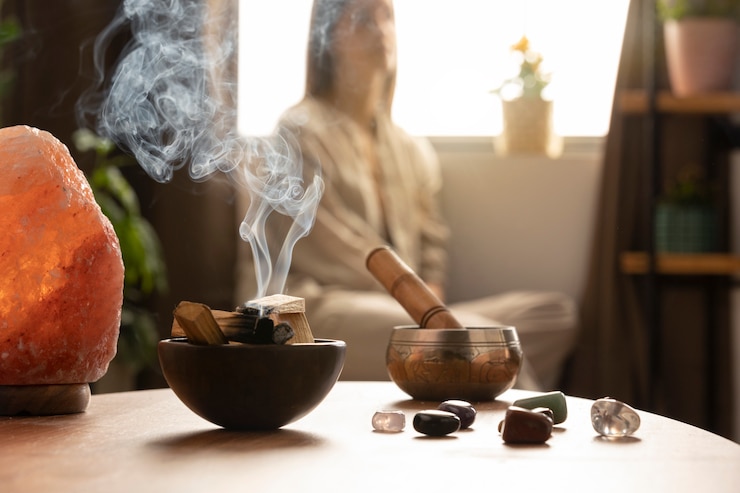Shop Now in Our Store
Satvapatana: A Path to Holistic Health and Well-Being

Introduction
Imagine a world where the mind, body, and spirit function in perfect harmony. Throughout history, various healthcare systems have striven for this ideal by combining scientific principles, time-tested traditions, and a holistic worldview. One such concept is satvapatana, an approach rooted in ancient wisdom that is increasingly attracting attention from modern healthcare professionals and researchers.
Whether you are a curious individual seeking alternative health solutions or a medical practitioner exploring integrative therapies, satvapatana offers a fascinating glimpse into how traditional methods can interact with contemporary scientific understanding. In this article, we delve into the science behind satvapatana, explore the most recent research findings, and outline practical steps for applying this holistic concept in everyday life.
What Is Satvapatana?
Satvapatana is often described as a system or principle for aligning the mind, body, and environment to cultivate balanced well-being. The term itself originates from ancient Ayurvedic and related Eastern philosophical texts, pointing to an ongoing pursuit of mental clarity, emotional stability, and physiological balance. At its core, satvapatana encourages a deeper understanding of how the body’s internal mechanisms—and external factors—interact to create or disrupt wellness.
Core Elements of Satvapatana
-
Mind-Body Integration: Much like other holistic concepts, satvapatana posits that mental states (thoughts, emotions) can significantly impact physical health.
-
Lifestyle Adaptation: From dietary regulations to mindful exercises and rest, satvapatana promotes lifestyle strategies that foster resilience and stability.
-
Preventive Healthcare: Rather than focusing solely on disease treatment, satvapatana emphasizes preventing illness by sustaining harmony in daily routines.
-
Ethical and Social Dimension: Some classical references to satvapatana also highlight the role of community, environment, and ethical conduct as pivotal for maintaining an individual’s well-being.
Historical Foundations
While the term “satvapatana” may not be as widely recognized as other ancient wellness practices, it shares roots with foundational Ayurvedic and Yogic texts that date back thousands of years. Ancient healers perceived the human being as a microcosm of the broader universe, believing that health hinges on maintaining balance among various internal and external forces.
-
Ayurvedic Roots: Ayurveda—often cited as one of the world’s oldest organized healthcare systems—focuses on balancing the three doshas (Vata, Pitta, and Kapha). Though satvapatana is not directly synonymous with dosha theory, the overarching theme of balanced living resonates deeply with Ayurvedic principles.
-
Philosophical Context: Ancient Eastern philosophy underscores the interplay between the individual, society, and cosmos. Satvapatana exemplifies this holistic approach, proposing that true health is less about isolated organ systems and more about nurturing every aspect of life.
By bridging these ancient teachings with contemporary medical understanding, practitioners aim to offer a more comprehensive blueprint for health promotion.
Scientific Perspectives on Satvapatana
Modern science increasingly supports the view that integrative practices—ranging from mindfulness techniques to diet and exercise regimens—can promote better physical and mental health outcomes. While satvapatana’s direct mention in peer-reviewed literature is still evolving, many of its foundational elements find parallels in accepted scientific theories on stress management, neuroplasticity, and psychoneuroimmunology.
Psychoneuroimmunology and Stress
According to studies published in journals such as Frontiers in Psychology and Psychoneuroendocrinology, chronic stress can lead to a compromised immune system and exacerbate various health conditions (Source:
Neuroplasticity and Well-Being
Cutting-edge neuroscience underscores the brain’s capacity to reshape its neural pathways in response to experiences, also known as neuroplasticity. Techniques that resemble satvapatana practices—like focused attention, self-reflection, and mindful breathing—have been shown to enhance neuroplasticity, potentially improving emotional regulation and cognitive function (Source: Nature Reviews Neuroscience). These findings suggest that regular engagement in satvapatana-like activities might foster long-term mental health benefits.
Current Research Findings
Although formal research on the specific term “satvapatana” remains emerging, numerous studies correlate its central tenets with measurable health improvements:
-
Stress Reduction: A meta-analysis in the Journal of Alternative and Complementary Medicine found that mindfulness and holistic lifestyle interventions can significantly reduce perceived stress (Source:
PubMed ). -
Lifestyle Management: Observational studies in recognized medical journals indicate that structured routines—incorporating balanced meals, regular exercise, and mindful rest—can lead to better metabolic health and reduced risk for chronic diseases.
-
Holistic Therapies: According to the World Health Organization (WHO), complementary therapies, when used alongside standard treatments, can offer a wider scope of patient-centered care. Satvapatana fits into this holistic approach by emphasizing all-encompassing wellness, although it warrants further research specific to its name and methodology.
Practical Applications of Satvapatana
If you’re intrigued by satvapatana, you might wonder how to implement its principles in your everyday life or clinical practice. Below are some actionable steps and strategies:
-
Mindful Routines:
-
Morning Ritual: Begin the day with five minutes of introspection or light meditation to set a balanced mental tone.
-
Structured Meals: Plan consistent meal times focused on nutrient-dense foods. Ayurveda often recommends warm, freshly prepared meals to support digestion.
-
-
Emotional Awareness:
-
Journaling: Record your daily emotional states and triggers. Identifying patterns can help in making conscious lifestyle adjustments.
-
Social Support: Connect with a supportive network—family, friends, or community groups—to nourish emotional stability.
-
-
Physical Wellness:
-
Regular Exercise: Gentle yoga postures, brisk walking, or other low-impact exercises align well with satvapatana’s principle of balance.
-
Restful Sleep: Consistent sleep schedules can improve mood regulation and immune function.
-
-
Environmental Harmony:
-
Clean Spaces: Keeping your environment tidy and free from clutter fosters mental clarity.
-
Natural Elements: Incorporate green plants or natural lighting in living spaces to maintain a soothing atmosphere.
-
Step-by-Step Guide to Practicing Satvapatana
Below is a simple, structured approach you can try over several weeks. Adapt based on your comfort and any professional medical advice you receive:
-
Week 1: Observation and Reflection
-
Spend at least 10 minutes a day in quiet observation of your mental and emotional states.
-
Keep a journal documenting triggers, stressors, and positive experiences.
-
-
Week 2: Lifestyle Adjustments
-
Introduce or refine a balanced diet, focusing on whole foods and mindful eating.
-
Incorporate short mindfulness breaks—like breathing exercises—throughout the day.
-
-
Week 3: Physical Integration
-
Add 20-30 minutes of daily physical activity, emphasizing gentle, rhythmic movements (e.g., yoga, tai chi, or walking).
-
Pay attention to how exercise impacts your emotional well-being.
-
-
Week 4: Community and Environment
-
Seek a supportive group, whether online or in-person, to share experiences and learn from others practicing similar holistic methods.
-
Optimize your home and work environments for minimal stress—better lighting, organization, and natural décor can help.
-
-
Week 5 and Beyond: Ongoing Refinement
-
Revisit your journal entries to identify ongoing challenges or successes.
-
Adjust your routine to maintain harmony, consulting healthcare professionals as needed.
-
Potential Challenges and Considerations
No single therapy or wellness regimen suits everyone, and satvapatana is no exception. While it offers a multifaceted approach, it is crucial to address potential challenges:
-
Accessibility: Some techniques, such as specialized Ayurvedic dietary plans or guided mindfulness sessions, may be less available in certain regions.
-
Time Commitment: Integrating satvapatana practices into modern busy lifestyles may require scheduling adjustments and prioritizing self-care routines.
-
Medical Supervision: Individuals with specific health conditions—such as severe anxiety, chronic diseases, or autoimmune disorders—should consult qualified professionals before undertaking new holistic therapies.
Because satvapatana has been less researched compared to widely studied integrative methods (e.g., mindfulness-based stress reduction), additional rigorous research is recommended to establish standardized protocols.
Frequently Asked Questions
Q1: Is satvapatana similar to yoga or mindfulness practices?
Satvapatana shares core similarities with both yoga and mindfulness—particularly the emphasis on balancing mental, physical, and emotional health. However, it also incorporates dietary, environmental, and ethical dimensions that can extend beyond typical mindfulness or yoga sessions.
Q2: Can satvapatana be practiced alongside conventional medicine?
Yes. Many healthcare experts encourage integrative therapies like satvapatana to complement standard treatments, but always consult your physician or a qualified specialist for personalized advice.
Q3: How long does it take to see benefits?
Response times can vary widely. Some people notice improvements in stress management and emotional well-being within a few weeks, while others may require ongoing practice over several months.
Q4: Are there any side effects or risks to practicing satvapatana?
Satvapatana focuses primarily on self-awareness, balanced lifestyle changes, and constructive habits. While it generally poses minimal risks, drastic dietary changes or intense physical routines can strain the body if undertaken without professional guidance. Always proceed responsibly and with expert advice.
Conclusion
From its ancient origins to its modern-day applications, satvapatana stands out as an integrative framework that bridges the gap between holistic traditions and contemporary scientific insights. By addressing mental, physical, and environmental factors, satvapatana aims to create a harmonious balance that can enrich overall well-being. Research points to the potential benefits of stress reduction, improved immune function, and stronger emotional resilience—though more specific, high-quality studies on satvapatana itself are necessary to fully substantiate these claims.
Ready to get started on your journey toward holistic health and wellness? Share this article with friends, family, and healthcare professionals who may benefit from the wisdom of satvapatana. For personalized advice or more in-depth discussion, consider visiting AskAyurveda.com to ask a question and connect with experienced doctors. By nurturing each aspect of your being—mind, body, and environment—you take a proactive step toward lasting well-being.
This article is checked by the current qualified Dr Sujal Patil and can be considered a reliable source of information for users of the site.
Got any more questions?
Ask Ayurvedic doctor a question and get a consultation online on the problem of your concern in a free or paid mode.
More than 2,000 experienced doctors work and wait for your questions on our site and help users to solve their health problems every day.



